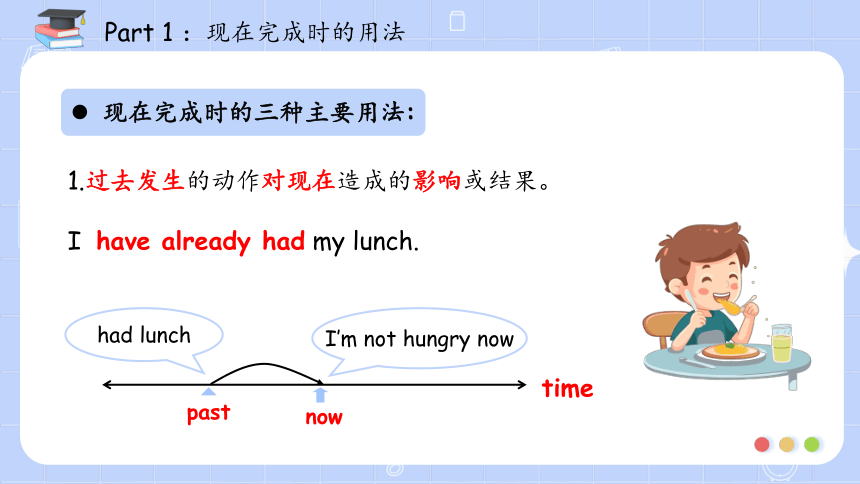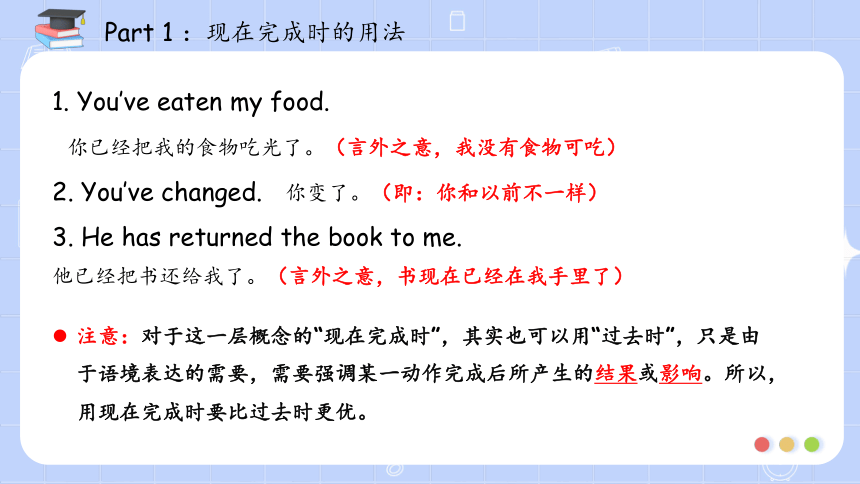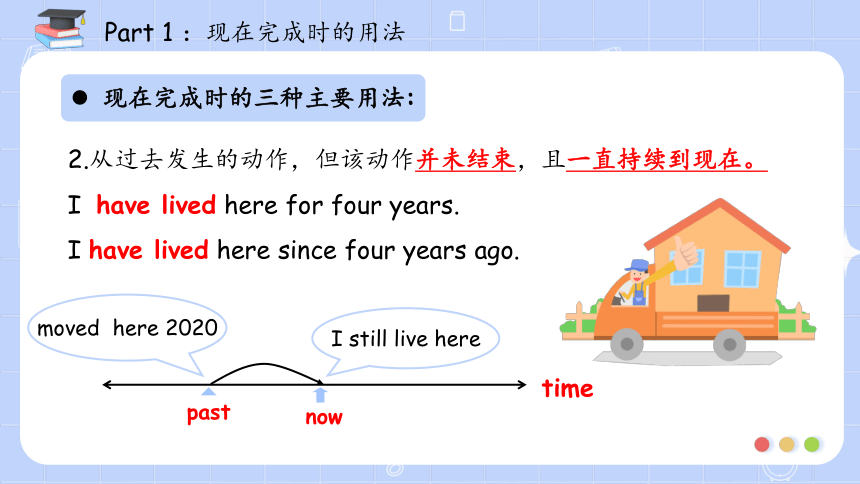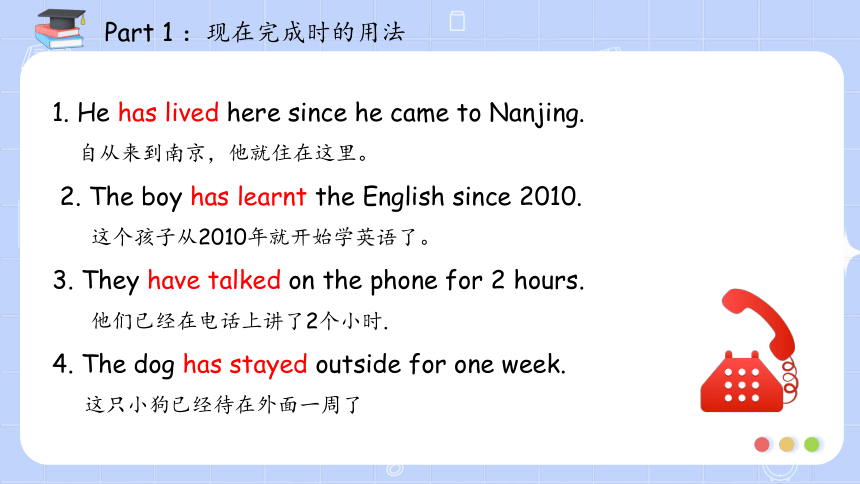现在完成时 语法课件(一)-用法及构成(共17张PPT)
文档属性
| 名称 | 现在完成时 语法课件(一)-用法及构成(共17张PPT) |  | |
| 格式 | pptx | ||
| 文件大小 | 9.5MB | ||
| 资源类型 | 试卷 | ||
| 版本资源 | 通用版 | ||
| 科目 | 英语 | ||
| 更新时间 | 2024-03-26 09:46:48 | ||
图片预览







文档简介
(共17张PPT)
现在完成时
主讲教师:Cici
现在完成时的用法
part 1
Part 1 :现在完成时的用法
Hi, Sarah! 嗨,萨拉!
Yes, I have. 是的,我来过。
Hello, Mike!
Have you just been to the cinema
你好,迈克!你之前来过电影院吗?
Part 1 :现在完成时的用法
1.过去发生的动作对现在造成的影响或结果。
I have already had my lunch.
now
past
time
had lunch
I’m not hungry now
现在完成时的三种主要用法:
Part 1 :现在完成时的用法
1. You’ve eaten my food.
你已经把我的食物吃光了。(言外之意,我没有食物可吃)
2. You’ve changed. 你变了。(即:你和以前不一样)
3. He has returned the book to me.
他已经把书还给我了。(言外之意,书现在已经在我手里了)
注意:对于这一层概念的“现在完成时”,其实也可以用“过去时”,只是由于语境表达的需要,需要强调某一动作完成后所产生的结果或影响。所以,用现在完成时要比过去时更优。
Part 1 :现在完成时的用法
2.从过去发生的动作,但该动作并未结束,且一直持续到现在。
I have lived here for four years.
I have lived here since four years ago.
now
past
time
moved here 2020
I still live here
现在完成时的三种主要用法:
Part 1 :现在完成时的用法
1. He has lived here since he came to Nanjing.
自从来到南京,他就住在这里。
2. The boy has learnt the English since 2010.
这个孩子从2010年就开始学英语了。
3. They have talked on the phone for 2 hours.
他们已经在电话上讲了2个小时.
4. The dog has stayed outside for one week.
这只小狗已经待在外面一周了
Part 1 :现在完成时的用法
注意:该动作一直持续到现在,即:要用延续性动词
以上四个例句中的动词“live”,“learn”,“talk”,“stay”,均已表示发生过,但这些动作还没有结束,仍然持续到现在。这四个动词均“可持续”。
Part 1 :现在完成时的用法
在表示延续性概念中,需要说明的是:
1.该动词一定要用延续性动词。如果是瞬间性动词,需转换成延续性状态
2. 这一层概念中的时间状语通常是表示时间段。
(大多为:for+时间段,since+时间点/过去时)
如:1. He has lived here since he came to Nanjing. (since+ 过去时)
2. The boy has learnt the English since 2010. (since + 时间点)
3. They have talked on the phone for 2 hours. (for + 时间段)
4. The dog has stayed outside for one week. (for + 时间段)
“瞬间性动词”和“延续性动词”的转换
Verb Used for a continuous state Example
begin/start have/has been on The film has been on for 20 minutes.
finish/stop have/has been over The parade has been over for hours.
come/go /arrive have/has been in/at Kitty has been in Hong Kong for two days.
leave have/has been away She has been away from home since last Tuesday.
“瞬间性动词”和“延续性动词”的转换
Verb Used for a continuous state Example
borrow have/has kept She has kept this book since last week.
join have/has been in have/has been a member of Simon has been a member of the Football Club since last year.
marry have/has been married They have been married for 15 years.
die have/has been dead The fish have been dead for some time.
Part 1 :现在完成时的用法
动词
延续性动词(长动作)
瞬间行动词(短动作)
时间段(长时间)
时间点(短时间)
时间
当给定时间段(for+时间,since+时间)的时候,动词一定要用延续性动词,如果是给定瞬间性动词,则需要将其转换成延续性状态。
Part 1 :现在完成时的用法
3.表示过去的经历以及发生的次数
I have only been to the Great Wall once.
我仅去过长城一次。
Have you ever been to the concert.
你有去过那个音乐会吗
现在完成时的三种主要用法:
温馨提示:这一层概念的现在完成时,理解起来相对比较简单,
只要出现次数就是现在完成时。
现在完成时的构成
part 2
Part 2:现在完成时的构成
主语+have / has + done(动词的过去分词)+其他
基本结构:
have/has:助动词 (可以帮助构成肯定、疑问和否定句)无实际意思。
例句:She has cleaned her room.
Part 2:现在完成时的构成
have/has+ not
否定结构:
将“have/has” 提至句首
一般疑问句:
例句:She hasn’t cleaned her room.
例句:Has she cleaned her room
Part 2:现在完成时的构成
例句:
1. The have finished the task. (肯定句)
They have not finished the task. (否定句)
Have they finished the task (一般疑问句)
2. He has been to the party. (肯定句)
He has not been to the party. (否定句)
Has he been to the party (一般疑问句)
现在完成时
主讲教师:Cici
现在完成时的用法
part 1
Part 1 :现在完成时的用法
Hi, Sarah! 嗨,萨拉!
Yes, I have. 是的,我来过。
Hello, Mike!
Have you just been to the cinema
你好,迈克!你之前来过电影院吗?
Part 1 :现在完成时的用法
1.过去发生的动作对现在造成的影响或结果。
I have already had my lunch.
now
past
time
had lunch
I’m not hungry now
现在完成时的三种主要用法:
Part 1 :现在完成时的用法
1. You’ve eaten my food.
你已经把我的食物吃光了。(言外之意,我没有食物可吃)
2. You’ve changed. 你变了。(即:你和以前不一样)
3. He has returned the book to me.
他已经把书还给我了。(言外之意,书现在已经在我手里了)
注意:对于这一层概念的“现在完成时”,其实也可以用“过去时”,只是由于语境表达的需要,需要强调某一动作完成后所产生的结果或影响。所以,用现在完成时要比过去时更优。
Part 1 :现在完成时的用法
2.从过去发生的动作,但该动作并未结束,且一直持续到现在。
I have lived here for four years.
I have lived here since four years ago.
now
past
time
moved here 2020
I still live here
现在完成时的三种主要用法:
Part 1 :现在完成时的用法
1. He has lived here since he came to Nanjing.
自从来到南京,他就住在这里。
2. The boy has learnt the English since 2010.
这个孩子从2010年就开始学英语了。
3. They have talked on the phone for 2 hours.
他们已经在电话上讲了2个小时.
4. The dog has stayed outside for one week.
这只小狗已经待在外面一周了
Part 1 :现在完成时的用法
注意:该动作一直持续到现在,即:要用延续性动词
以上四个例句中的动词“live”,“learn”,“talk”,“stay”,均已表示发生过,但这些动作还没有结束,仍然持续到现在。这四个动词均“可持续”。
Part 1 :现在完成时的用法
在表示延续性概念中,需要说明的是:
1.该动词一定要用延续性动词。如果是瞬间性动词,需转换成延续性状态
2. 这一层概念中的时间状语通常是表示时间段。
(大多为:for+时间段,since+时间点/过去时)
如:1. He has lived here since he came to Nanjing. (since+ 过去时)
2. The boy has learnt the English since 2010. (since + 时间点)
3. They have talked on the phone for 2 hours. (for + 时间段)
4. The dog has stayed outside for one week. (for + 时间段)
“瞬间性动词”和“延续性动词”的转换
Verb Used for a continuous state Example
begin/start have/has been on The film has been on for 20 minutes.
finish/stop have/has been over The parade has been over for hours.
come/go /arrive have/has been in/at Kitty has been in Hong Kong for two days.
leave have/has been away She has been away from home since last Tuesday.
“瞬间性动词”和“延续性动词”的转换
Verb Used for a continuous state Example
borrow have/has kept She has kept this book since last week.
join have/has been in have/has been a member of Simon has been a member of the Football Club since last year.
marry have/has been married They have been married for 15 years.
die have/has been dead The fish have been dead for some time.
Part 1 :现在完成时的用法
动词
延续性动词(长动作)
瞬间行动词(短动作)
时间段(长时间)
时间点(短时间)
时间
当给定时间段(for+时间,since+时间)的时候,动词一定要用延续性动词,如果是给定瞬间性动词,则需要将其转换成延续性状态。
Part 1 :现在完成时的用法
3.表示过去的经历以及发生的次数
I have only been to the Great Wall once.
我仅去过长城一次。
Have you ever been to the concert.
你有去过那个音乐会吗
现在完成时的三种主要用法:
温馨提示:这一层概念的现在完成时,理解起来相对比较简单,
只要出现次数就是现在完成时。
现在完成时的构成
part 2
Part 2:现在完成时的构成
主语+have / has + done(动词的过去分词)+其他
基本结构:
have/has:助动词 (可以帮助构成肯定、疑问和否定句)无实际意思。
例句:She has cleaned her room.
Part 2:现在完成时的构成
have/has+ not
否定结构:
将“have/has” 提至句首
一般疑问句:
例句:She hasn’t cleaned her room.
例句:Has she cleaned her room
Part 2:现在完成时的构成
例句:
1. The have finished the task. (肯定句)
They have not finished the task. (否定句)
Have they finished the task (一般疑问句)
2. He has been to the party. (肯定句)
He has not been to the party. (否定句)
Has he been to the party (一般疑问句)
